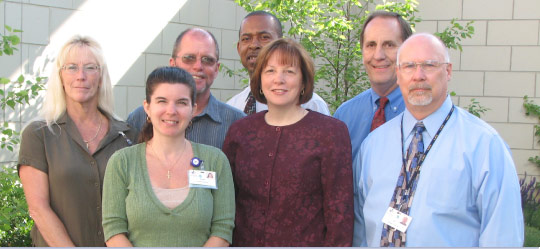Civista Green Team

CIVISTA’S “GREEN TEAM” INCREASES ENVIRONMENTAL INITIATIVES
As Civista Medical Center’s Green Team seeks to reduce toxins and provide a healthier, healing environment it has stepped up its efforts to increase awareness and participation in several initiatives designed to save energy and conserve resources. By taking up green practices, whether incrementally or from the ground up, they are managing to lower energy bills, reduce waste and achieve healthier indoor air. This makes good sense for the health of the entire community: patients, staff and visitors.
The Green Team is a multi-disciplinary group led by Lauri Cress, Director of Facilities at Civista. The team includes members from Engineering, Environmental Services, Materials Management, Nursing, Laboratory Services and Nutritional Services. Focus initiatives include:
- Waste Reduction and Recycling — Converting from single use to multiple use products. Recycling of cans, blue wrap, plastic, batteries, white paper, toners, cardboard, and waste. Regulated medical waste segregation and minimization. Reducing, reusing and recycling general waste, and furniture and equipment that are no longer needed. According to Cress, in the first month of the Green Team’s efforts, over a ton of waste was taken out for recycling. Partnering with Verizon, cell phones and accessories are recycled and given to Civista’s designated site — the local women’s shelter. Every department at Civista is involved in waste reduction and recycling. The use of paper handouts in meetings has been significantly reduced or eliminated, with increased use of computer Power Point documents instead.
- Sustainable Foods — Nutritional Services has been actively involved by providing more fresh, nutritious, organic, and local food choices for patients, while using hormone-free and/or antibiotic free products. Seafood is from a sustainable source. The use of styrofoam products on patient trays has been eliminated. Using disposable serving items which are not cost prohibitive and are not environmentally hazardous is being explored. Refillable hot and cold drink mugs are now offered and the users can get reduced-price refills.
- Energy Conservation — Energy audits are being conducted, a Lights Out Campaign will be conducted and energy conserving light fixtures are being used. The Campaign focuses on rooms and areas where lights do not need to be on continually. Motion sensors have been installed in areas where lights need only be on when someone is in the room. This should result in substantial energy and cost saving with a facility as large as Civista Medical Center. Plumbing fixtures including toilets and sinks have been upgraded. Automatic doors have been analyzed and some are taken off automatic sensor, where and when appropriate, to conserve energy. A standard building temperature has been established, with the exception of patient rooms.
- Environmentally Preferable Purchasing — To prevent spread of infection in hospitals, it’s important to reduce exposures to germs—especially for patients with compromised immune systems—but the use of harsh chemical cleaners can cause respiratory problems. Green products are now being used in environmental services and cleaning products. This has contributed to employee satisfaction due to the reduction of odors and the use of caustic chemicals. Carpeting which does not produce offgassing has been installed. Mercury-free products and those made from recycled materials are being used; along with environmentally preferred packing.
Green initiatives implemented during the expansion and renovation of Civista Medical Center include plumbing fixtures, carpeting, and energy efficient light fixtures. Studies have shown that poor indoor lighting increases levels of stress in hospital workers, leading to compromised medical care. “Daylighting” (that is, bringing daylight indoors with enlarged windows, light wells, clerestory windows and reflective surfaces), not only improves work performance but has been shown to improve patient recovery rates, while saving energy. This is being used effectively in the construction of the South Tower and the new atrium lobby. In addition, we greened our grounds with the aesthetic and therapeutic pleasures of our healing garden.
Cress stresses, “We are looking at significant savings in our energy consumption. Civista is working with Maryland H2e (Hospitals for a Healthier Environment) and Practice Green Health. We will be measuring our carbon footprint to determine our successes as the Green Team works to make Civista the healthcare leader in environmental excellence.”


